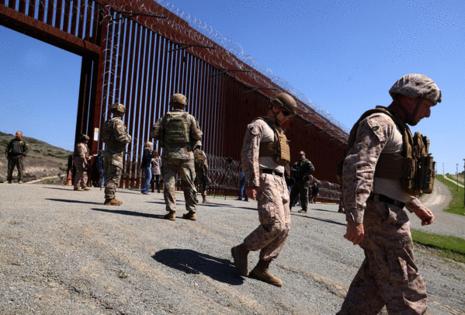California-Mexico border, once overwhelmed, now nearly empty
Published in News & Features
When the humanitarian aid workers decided to dismantle their elaborate tented setup — erected right up against the border wall — they hadn't seen migrants for a month.
A year earlier, when historic numbers of migrants were arriving at the border, the American Friends Service Committee, a national Quaker-founded human rights organization, came to their aid. Eventually the group received enough donations to erect three canopies, where it stored food, clothing and medical supplies.
But migrant crossings have slowed to a near halt, bringing a striking change to the landscape along the southernmost stretch of California.
Shelters that once received migrants have closed, makeshift camps where migrants waited for processing are barren, and nonprofits have begun shifting their services to established immigrants in the U.S. who are facing deportation, or migrants stuck in southern Mexico.
Meanwhile, the Border Patrol, with the assistance of 750 U.S. military troops, has reinforced six miles of the border wall with concertina wire.
On a recent day at the aid station erected by the Service Committee a few miles west of the San Ysidro border crossing, just one mostly empty canopy remained. Three aid workers wearing blue surgical gloves were packing up boxes labeled "kids/hydration," "tea and hot coco" and "small sweater." There was no need for them now.
Border Patrol agents in the San Diego sector are now making about 30 to 40 arrests per day, according to the agency. That's down from more than 1,200 per day during the height of migrant arrivals to the region in April.
Adriana Jasso, who coordinates the U.S.-Mexico program for the Service Committee, recalled that hectic time and the group's aid effort. "This was the first time we took on this level of providing humanitarian aid," Jasso said.
But these days, she said, "it's the closing of an experience — for now. Because life can be unpredictable."
In May 2023, the Biden administration ended a pandemic-era policy under which migrants were denied the right to seek asylum and were rapidly returned to Mexico. In the lead-up to the policy change, migrants descended on the border by the thousands.
Two parallel fences make up much of the border barrier near San Diego. Asylum seekers began scaling the fence closest to Mexico and handing themselves over to Border Patrol agents, who would tell them to wait there between both fences for processing.
Days often passed before agents returned to the area, known as Whiskey 8. In the meantime, Jasso and her colleagues doled out hot instant soup, fresh fruit and backpacks through the slots in the fence.
The last time Jasso saw any migrants there was Feb. 15 — a 20-person group made up mostly of men from India and China.
Then a storm came in, dislodging two of the canopies. Jasso and her team took that as a sign to tear the rest of it down. The stench of the contaminated Tijuana River wafted in the morning air as Jasso hauled out a plastic shelving unit from the canopy.
Inside the canopy, one of the last remaining items was a stuffed Minnie Mouse, her bubblegum pink shoes shaded gray with dirt. A young girl had handed it to Jasso through the fence.
"Border Patrol refused to let her take it," Jasso said. "I promised her I would take care of it and that somebody would love it as she did."
Just as Jasso was packing up at Whiskey 8, Border Patrol held a news conference a few miles away.
Parked against the border wall, east of the San Ysidro border crossing, a Border Patrol SUV and a green Humvee served as a backdrop to illustrate the partnership between the departments of Homeland Security and Defense.
A gate in the barrier opened and Border Patrol, Marines and Army officials showed reporters how both fences were now sheathed in concertina wire.
Loud music could be heard from Tijuana, where construction workers were building an elevated highway right up against the wall separating Mexico from the U.S.
Troops created an "obstacle design" by welding metal rods to the top of the fence, pointing toward Mexico, and attaching more layers of wire over that.
Jeffrey Stalnaker, acting chief patrol agent of the San Diego sector, said the additional wire, installed since troops arrived on Jan. 23, has slowed illegal entries.
Stalnaker said federal prosecutors in San Diego had also accepted more than 1,000 border-related criminal cases this fiscal year. And following Trump's tariff threats, Mexico vowed to send 10,000 National Guard troops to its northern border. Those troops now meet with U.S. agents a few times a week and conduct synchronous patrols on their respective sides of the border, Stalnaker said.
"What we see behind us here today is the result of a true whole-of-government effort, from the Marines laying down miles of concertina wire along the border infrastructure to the soldiers manning our scope trucks and remote video surveillance cameras," he said.
Only Border Patrol agents can arrest migrants entering the country illegally, but Stalnaker said that using military personnel to detect migrants has freed agents to spend more time in the field.
Last April, San Diego became the top region along the border for migrant arrivals for the first time in decades. Stalnaker said there's been a 70% decrease in migrant arrests so far this fiscal year, compared to the same period last year.
"To say there has been a dramatic change would be an understatement," he said.
But Stalker noted that Border Patrol expects an increase in attempts by migrants to enter California by boat "as we continue to lock down the border here and secure it."
Farther east, Jacumba Hot Springs was once the site of additional open-air camps, where hundreds of migrants slept on plastic tarps (or in tents, if they were lucky) and huddled around campfires fueled by brush to stay warm.
Sam Schultz, a retired international relief worker who has lived near Jacumba for nine years, once made daily deliveries of water, hot meals and blankets to migrants there. When the camps popped up a few miles from his home, he felt compelled to help.
The tents that once covered a camp site just off Old Highway 80 are gone. Schultz's son recently hauled them away because they're no longer needed.
Schultz still visits three sites a few times a week to check if water left out for migrants needs replenishing.
"The water hasn't been touched," he said.
Legal aid and humanitarian organizations that helped migrants have shifted their operations away from the border.
Immigrant Defenders Law Center, headquartered in Los Angeles, served migrants who were bused there from the border by the Texas governor; the group also provided legal help to those waiting in Tijuana for appointments with Customs and Border Protection. After his inauguration, President Trump quickly canceled existing appointments and ended use of a phone application used by the Biden administration to schedule them.
Lindsay Toczylowski, the law center's co-founder and CEO, said that since arrests by immigration agents have increased around Los Angeles, the organization has begun to focus on defending recently detained immigrants from deportation.
Erika Pinheiro, executive director of Al Otro Lado, said many of those deported to Mexico are being sent farther south, so there aren't as many people stuck in Tijuana. She said the organization has brought staff to Mexico City and to Tapachula, which borders Guatemala.
Pinheiro said the San Ysidro-based organization recently scaled up a project supporting non-Spanish-speaking migrants in Mexico — refugees who now cannot seek asylum in the U.S. but also can't safely return to their country of origin.
The American Friends Service Committee has also shifted its work to focus on offering "know your rights" presentations at schools, churches and community centers.
But back at Whiskey 8, Jasso said the organization will continue offering direct humanitarian aid to migrants moving forward.
She recalled learning about three migrants who died earlier this month in the Otay Mountain wilderness after calling for help during a storm that brought near-freezing temperatures to the harsh terrain.
With migrants now unable to seek legal ways of entering the U.S. through the asylum process, advocates anticipate that more will begin to risk their lives by attempting to enter illegally through more remote and dangerous terrain. Some desperate enough might even try to jump over all the newly installed concertina wire.
_____
©2025 Los Angeles Times. Visit latimes.com. Distributed by Tribune Content Agency, LLC.







Comments